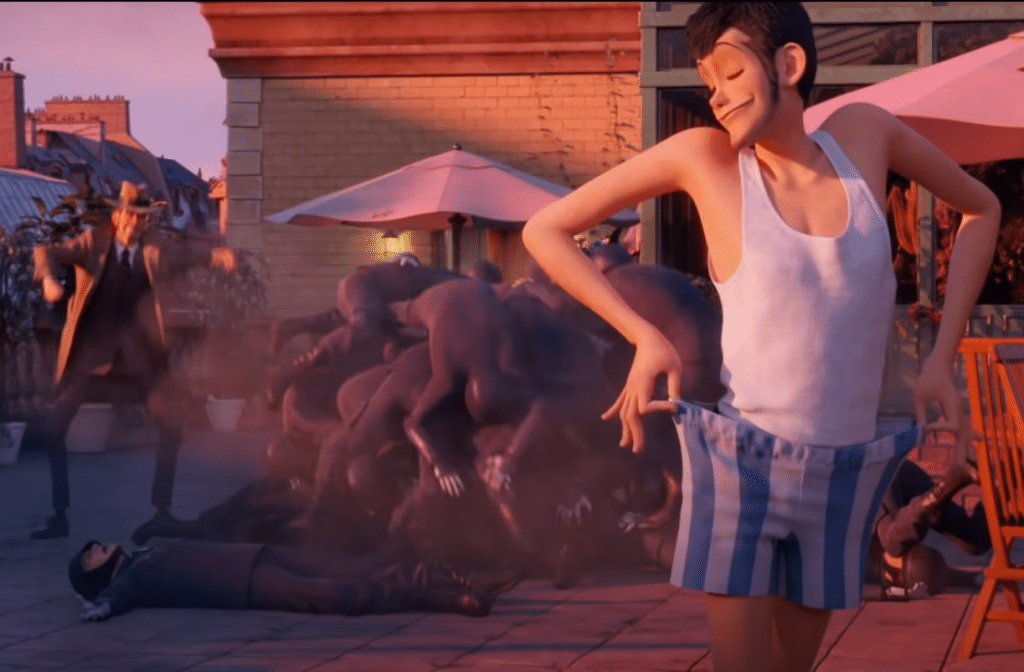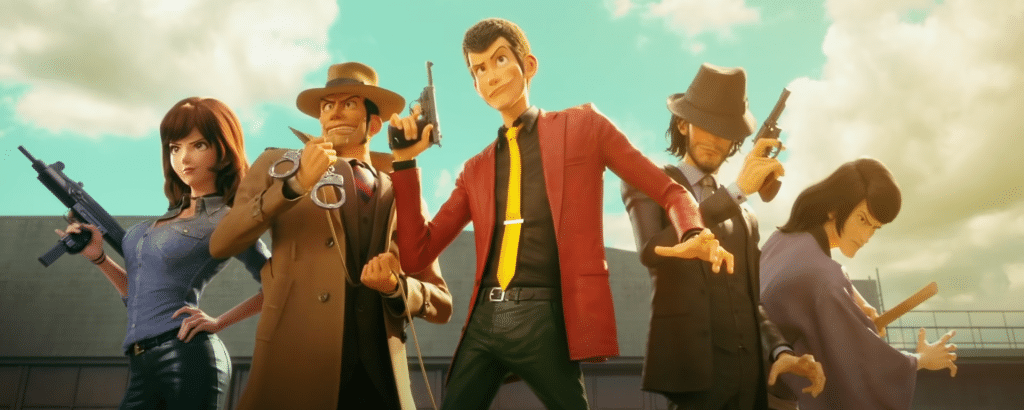Lupin III: The First is available to rent for streaming from YouTube, Google Play, and Apple TV, among other services.
Lupin III: The First absolutely blew me away.
Not just because outside circumstances delayed its U.S. release, adding a solid year's worth of anticipation.
But because, quite frankly, it might be the best-looking CGI movie I've seen from an anime studio.
And arguably the biggest part of that? Y'know, aside from the fact that the animators at Marza do such solid work that they've kept the Sonic games look absolutely slick for over a decade now?
It's… pretty obvious that Lupin III: The First came out a little more than a year after Into the Spider-Verse.
Just take a look at the opening title sequence:
It's just so playful and stylized without breaking its stride in the slightest. Even outside the actual 2D effects like smoke and gunshots, this feels like the platonic ideal of “traditional anime, translated into 3D”.
Lupin's arms swing when he runs in a way that feels almost rubbery. The Fiat peels out like an absolute cartoon. They even cheat the angle on Jigen's hat so that his eyes stay obscured, just like the show.
First and foremost, Lupin III: The First is a movie for the series' fans.
And second, Lupin III: The First is a movie for fans of genre fiction on the whole.
Play the Hits
It's not that hard to see where Lupin III has picked up other ideas over the years to keep its fire burning.
Case in point: this plot could just as easily belong to an Indiana Jones flick.
Seriously. The plot goes like so:
- Fail to obtain a historical artifact in the first scene.
- Discover that The Nazis are at it again.
- Do some research to track the MacGuffin back down.
- Have a dogfight. Crash the plane.
- Travel to remote setpiece and pass a temple's “trial of worthiness”.
- Discover that the relic is supernatural.
- Seal the danger away and ride off into the sunset.
It's not like LucasFilm patented the rights to this style of action-adventure story in '81, of course. But this follows the formula arguably closer than even The Adventures of Tintin, something normally pitched as “Indiana Jones as a Belgian Youth”.
It's just that Lupin does it with his classic flair.
He swims through the air like a Tex Avery character, making you believe for a moment that he could survive jumping from a Nazi-controlled plane. He escapes custody thanks to an accomplice slicing an armored transport down the middle, handily outdoing the stock parody of samurai flicks. And, of course, his flashy slight-of-hand would be physically impossible if he didn't flaunt the laws of physics as readily as he did laws against burglary.

But, at the end of the day, so much of this movie still feels like a playful take on existing existing elements, even those pulled from Lupin's own adventures. The entire “Lupin & Friends chase treasure” premise smacks of Castle of Cagliostro. This isn't the first time he's foiled a villain wielding this specific kind of superweapon, either.
And, as noted, seeing over an hour of characters make exaggerated, highly-elastic moves from pose to pose in CGI is going to feel a bit familiar to Spider-Verse fans.
Now, is any of this a knock against The First?
Absolutely not.
The movie is just gorgeous under its own power, from the absolute charisma of the characters to its immaculate texture work.
Seriously, how often do you notice the mahogany and velvet on a nice chair?
And this is the first time it's been clear to me that Lupin's suit-jacket is made of leather. Forty years of the franchise, and that's the kind of detail that they can still fill in here in a way that doesn't quite take in manga or traditional animation.
Which sounds superfluous at a glance. But it tells us so much, or at least gives us new questions. Is his jacket some kind of reinforced material? Did he have it custom-made despite being on a cup-noodles-for-lunch budget? Was leather just in-fashion in the '60s?
Who knows!
And, on top of all that polish, it's just an utter celebration of everything the series has been up to this point. The title card plays in like an episode of the classic show. When he leaps, Lupin lingers just a bit too long at the top of his jump, posing like the cartoon character he is. His persona feels like a mash-up of his “mentor” persona from the 2018 series, his cartoonish streak in the '80s, and even brief flashes of his scummier behavior from the very earliest episodes.
If you can think of a recurring character “bit” from the old stories, from his instant-noodle lunches to the Inspector scribbling on his face, it probably gets a quick nod.
Because Lupin is, by nature, a legacy character. He always has been – just look at the III in the title. Even if the tone is nothing like LeBlanc's Lupin books, these stories are inseparable by nature. They even share the same mission statement: timeless, serialized stories about a charming, only-somewhat-villainous thief.
Every time somebody takes a swing at re-adapting an old property, they always talk about “honoring the original while bringing it into the modern age”.
Well, Lupin III: The First walks the walk.
It's not that's what's old is new again. It's that these creators never let Lupin never became old. What worked then is so fundamentally strong that it still works now – so well that it's inspired a whole modern generation of “gentleman thief” stories.
The writers trust in that core concept, and the animators trust that, with a bit of tuning, people still buy in on his charisma.
I know I sure have.
And while hope he can keep growing with the world around him, I sure hope he never changes.


